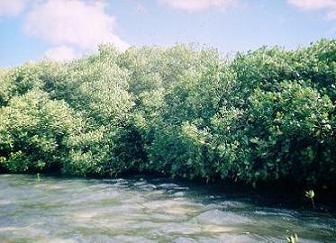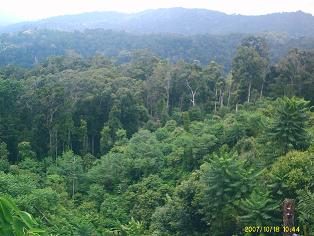
 |
|
|
|---|
| Lowland Rainforests in Java (and Bali) do not have one dominant species or one dominant family of plants, and the variability in species composition is such that no typical assemblage can be described. However, four dominant species are common. These are Artocarpus elasticus, Dysoxylum caulostachyum, Langsat (Lansium domesticum) and Planchonia valida (Kartawinata 1975). |
 
|
|---|
Swamp forests have all but disappeared from Java and may never existed on Bali. It is estimated that they once covered an area of 72,000 ha, but that now only 7,700 ha remain (Whitten et al. 1996). They were generally formed in depressions of volcanoes or behind riverbanks. Little has been written on the fauna of these Javan swamps.
Mountain forests show similar vegetation to that described for Sumatra in this Report. However, the vast array of mountains in Java has provided a natural laboratory to study variation between mountain flora and vegetation. Van Steenis (1972), among others, found that the composition of plant communities can differ significantly between mountains or even neighboring ridges as a result of minor differences in aspect or age of soil. As with other islands, the demarcation between lower mountain and lowland forests is at about 1000 m altitude and is largely floristic. The lower boundary of the Upper Montane Forests in most of Southeast Asia is generally quite abrupt, but on Java there is a gradual change, probably because the volcanic soils are relatively nutrient rich (Whitmore 1984). Lower Montane Forests in Java are characterized by oaks (Lithocarpus and Quercus), chestnuts (Castanopsis) and numerous species of laurels (Fagaceae and Lauraceae) (Mukhtar and Pratiwi 1991). The Upper Montane Forest and Sub-alpine Forest have an assemblage of plants similar to that described for Sumatra.
Java’s mammals, like its flora, are less rich in species than Borneo and Sumatra, but Java does have a high level of mammal endemicity. Its terrestrial mammal fauna consists of 137 species, including 18 rats and mice, and 68 bats (Sody 1989, Kitchener and Maryanto 1993).
Sody (1933) was correct in stating that the Bali mammal fauna was an impoverished form of that on Java, although a further four species of bat have been added to Bali since then (Kitchener and Foley 1984 and Kitchener et al. 1993). A collection on Kangean Island in 1982 added an additional 10 species of bat to the fauna of that island (Bergmans and van Bree 1986). |
|---|
Source : Report on Biodiversity and Tropical Forests in Indonesia, USAID/Indonesia, 2004. |
 |
 |
|---|
|
||||||||||||||||||||||||||||
|---|---|---|---|---|---|---|---|---|---|---|---|---|---|---|---|---|---|---|---|---|---|---|---|---|---|---|---|---|
|
|
||||||||||||||||||||||||||||